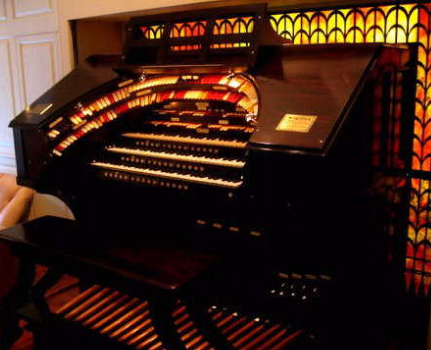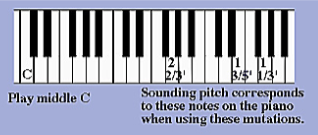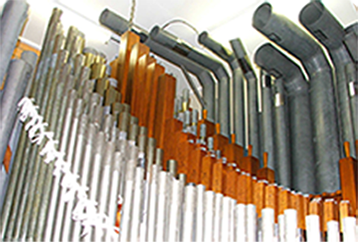 Up to this point we have described Theatre Pipe Organ stops with pitches which are an octave apart, and with footages that halve or double, ie 64’, 32’, 16’, 8’, 4’, 2’ and 1’. You will recall that 8’ is unison pitch, the same as on an acoustic piano, and that for an 8;’ stop, the pipe which plays the lowest C on the keyboard is approximately 8 feet long. If you were to play a note with stops activated for all seven of the footages, (You would probably never do this) you would hear the same note at 7 different pitches.
Up to this point we have described Theatre Pipe Organ stops with pitches which are an octave apart, and with footages that halve or double, ie 64’, 32’, 16’, 8’, 4’, 2’ and 1’. You will recall that 8’ is unison pitch, the same as on an acoustic piano, and that for an 8;’ stop, the pipe which plays the lowest C on the keyboard is approximately 8 feet long. If you were to play a note with stops activated for all seven of the footages, (You would probably never do this) you would hear the same note at 7 different pitches.
Mutation stops add a sound to the note being played that is not the same note, but rather a note that is in harmony with it. The use of Mutations gives the organ a rich, bright, colorful sound.
The footage nomenclature on Mutation stops is always a whole number plus a fraction. ie 10 2/3’, 5 1/3’, 2 2/3’, 1 3/5’, 1 1/3’. .
Stops with 3 as the denominator of the fraction always produce additional sound a fifth above the fundamental note. This means that playing middle C, using a 2 2/3' or a 1 1/3' stop will always play a G as well as middle C. This applies to any note you play in the rank. (To figure out the fifth of the note you are playing, simply count up 7 keys on the keyboard, [black and white keys]. The seventh note from the starting point is the fifth of that note.)
Stops with a 5 as the denominator of the fraction, such as 1 3/5’, will add sound a third above the fundamental note. Playing middle C will also play an E. (To figure out the third, count up 4 black and white keys from the starting key.)
The whole number in the footage nomenclature of a Mutation stop indicates in which octave the added harmonic note will sound. For example, the 2 2/3' will sound in the octave between the 4' and 2' pitches, or one octave and a fifth above the note being played. The 1 3/5' stop will sound between the 2' and 1' pitch, or two octaves and a third above the note being played. The 1/1/3 stop will sound between the 2’ and 1’ pitches, or two octaves and a fifth above the note being played. The 5 1/3’ stop will sound between the 8’ and 4’ pitches, or a fifth above the note being played. (See diagram below for examples).

If Mutations sounded closer to 8' pitch, they would not produce the sparkle which makes them so wonderful.
Mutation stops are commonly available on Theatre Pipe Organs in the flute/tibia ranks. They can also be found in string and diapason ranks.
Let’s say you are playing a song and want to produce a haunting quality. Remove the 4’ tibia from your registration, substitute a 5 1/3’, and listen to the remarkable difference in sound. Mutations are also frequently used in Theatre Pipe organ playing to create an “oriental” effect to the music.
A few Theatre Pipe Organs offer a 10 2/3’ Mutation stop in the Pedal. It is always used in conjunction with a 16’ stop. The combination of the 10 2/3 Mutation Stop and the 16’ Stop is called a Resultant. When played in the bottom octave, it produces a musical effect simulating the sound of a 32’ stop, without having to build an extremely tall rank of 32’ pipes.










